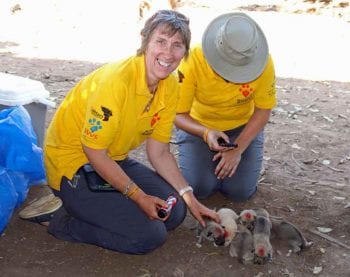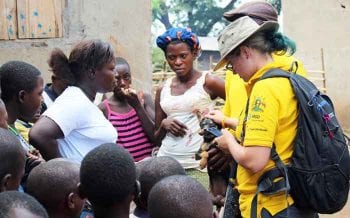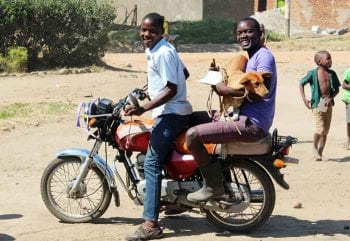15 Apr 2019
Joy Howell recounts her role in a volunteering trip to Africa to help locals in their ongoing mission to eliminate this viral disease.

The Mission Rabies team.
Volunteering is a great way to do something for others and research has shown it benefits people of all ages through increasing feelings of self-esteem, respect, motivation and well-being (Mental Health Foundation, 2012).
Having started my veterinary nursing career at the RVC Beaumont Sainsbury Animal Hospital in 1983, I was immediately introduced to the personal rewards of working in the charitable sector.
The hospital provided affordable treatment for the pet owners of Camden, London, and I particularly enjoyed working alongside Dogs Trust when it first established the Hope Project (Dogs Trust, 2019), neutering and vaccinating dogs owned by the homeless.
With regards to voluntary work, 2003 turned out to be a very important year for me. I first visited Uganda to go mountain gorilla trekking and fell in love with the country, and have been involved with charity work out there ever since. That year was also a turning point for me because I met the inspirational Luke Gamble.
Luke founded Worldwide Veterinary Service (WVS) at the end of 2002 and it was registered as a charity in 2003. He realised many animal charities and sanctuaries are often run by extremely well-meaning people whose requirement for veterinary aid and assistance is drastically affected due to the expense, and availability in the country they are based. The idea was developed to create an organisation that could pool veterinary resources, and direct them to assist animal charities and non-profit organisations around the world.
Having volunteered for WVS on a couple of occasions – working in Uganda with teams of vets and primary school teachers – when it developed an initiative to form Mission Rabies, I knew one day I must volunteer with this charity, too.
More than 99% of human rabies cases are caused by an infected dog bite. Once symptoms of the disease develop, it is always fatal. Every year, millions of healthy dogs are inhumanely killed for fear of this deadly disease. However, this doesn’t halt the spread of rabies, which causes the deaths of around 60,000 people a year – the majority of which are children younger than 15 years of age. Mission Rabies is going to change that.
Science has shown the most effective long-term rabies control strategy is through vaccination of dogs in endemic areas. Following World Health Organization (WHO) guidelines, Mission Rabies runs mass canine vaccination drives and educates local communities on rabies prevention. The results speak for themselves, with the number of human rabies deaths falling every year.
My Mission Rabies Uganda journey started in February 2018, when I agreed to help with a recce of the district of Kasese, to help the Mission Rabies team assess whether a pilot scheme would be viable. I spent a couple of days with Godfrey Kalule, the district veterinary officer, and visiting local amenities to fact-find.
I was delighted that, as I returned to the UK, the pilot project had gone live on the website and straight away, volunteers started to apply.
So, the adventure began. I needed my rabies booster and as Mission Rabies had invited me to be a team leader, I also needed to update my first aid at work certificate, so the preparation began.
In the subsequent months, I read the excellent guidance notes provided and the team regularly updated me on how to get ready for the trip. I knew it would be busy for me, as I was also planning to support the Ugandan logistical team.

Before I knew it, I was at the airport and boarding my flight to what would turn out to be one of the most rewarding projects of my life. I arrived two days ahead of the rest of the team and volunteers, to allow me to catch up on my own projects. Since 2004, I have been coordinating educational projects working with the Rotary Club of Kabale in Uganda, which made me an honorary member in 2013.
The day before the Mission Rabies team arrived, I also managed to meet the team from Daktari Andorra, which was to partner with us. Jesús Muro Figueres, veterinary officer from the Andorran government, is chief executive of Daktari Andorra, which he formed in 2010.
His team of vets and vet students from Andorra, Spain and Uganda was to partner with Mission Rabies, providing sterilisation and treatment from its mobile field clinic.
On 4 July, the UK and international volunteers all finally met at their hotel in Entebbe. The Mission Rabies veterinary team, programmes and research intern (now international projects officer) Amy Lewis, and international veterinary projects manager Jordana Burdon Bailey were there to introduce us to one another.
A team of women from the US and UK, an RVN (me), a vet technician, vets, vet students, non-vets and a hopeful vet student were ready for their adventure.
With all the logistical supplies packed into our project vehicles, including a fridge-freezer containing the valuable rabies vaccines donated by MSD Animal Health, I made up the advanced party, traversing the width of Uganda to set up the accommodation.
The rest of the team followed a few hours later, giving them time to enjoy the stunning and varied scenery across this beautiful country, and when we all next met, we were south of the equator in our base at Euphorbia Lodge on community land in Queen Elizabeth National Park.
The team had already seen Uganda’s diverse landscapes as they drove through temperate areas, tea and coffee plantations, banana farms, mountains and savannahs.
Little would they know that over the next few days they would cross the equator 20 times, and each early morning and evening, they would get a mini game drive as, every time they commuted into Kasese, they would see tree-climbing lions, elephants, hippos, warthogs, antelope and buffalo.

The next morning we all had the luxury of a lie in – for the final time for nine days. We woke up to an amazing African sunrise and enjoyed our breakfast before travelling to Kasese with the Daktari team to meet the local Ugandan vets and vet students who we were to be working with closely over the next eight days.
Amy and Jo briefed us on the project’s aims and demonstrated the WVS Data Collection App. Based on WHO recommendations, to create herd immunity within the canine population, 70% of the dogs need to be vaccinated. The app enables remote management of teams throughout unfamiliar areas, ensuring locations are vaccinated efficiently and without repetition.
Teams record the details of dogs being vaccinated and conduct surveys to demonstrate the required percentage vaccination coverage has been achieved.
We then discussed the formation of teams and I became leader for team “Virunga”. The teams would comprise of at least one vet or vet nurse/technician able to administer vaccinations, and both international and local volunteers to facilitate translation of “local language”. Roles would include:
The following morning we met for breakfast and left the camp at 6am. For the next eight days we would leave at 6am and finish work around 4pm before heading home. Each evening we enjoyed amazing vegetarian dinners provided by Pascal and the AJ tours team, and being in the middle of a national park, surrounded by its wildlife.
We spent the first two days of the project running various static points across the city and surrounding villages, where owners could bring their dogs for free vaccination. This was a great way to become familiar with data collection and processes before we would have six further days of door-to-door programmes, which involved being on the move throughout the day.
Team Virunga’s first day was in a village on the mountain side and we set up in the centre of a village under the shade of a tree. Having advertised on the radio for several days ahead of the project, and by the use of the Ugandans’ much-loved loudspeaker, we mobilised 100 animals on that first day. We developed a system of Dr Kalule vetting in and gaining information for Alice (who was hoping to become a vet student) to input the data, while I administered the vaccine and marked each animal with a clear red (animal safe) paint to make them visible to the post-vaccination survey teams, who would collect data over the following days.
Fortunately, our Ugandan vet student then completed the vaccination certificate and distributed educational material, including information on neutering to refer dogs to Daktari for surgery. The next day was in the centre of the town and we had an audience of more than 50 people throughout.
Day three was the start of door to door, which allowed us to see the intimate parts of the city – where people lived, the markets they went to, how communities were organised, the ways dogs were kept and how village life went on as a whole.
For the next five days, six teams systematically worked their way across the whole of Kasese municipality, seeking out each and every dog to ensure the optimal 70% vaccination coverage is reached.
I loved every moment, even the 12-hour days and returning home completely filthy – and, on a couple of days, covered in flea bites. None of that mattered, as I really felt we were making a difference. I also really enjoyed working with the Daktari sterilisation team, seeing how it could do a high number of surgeries in a field clinic without compromising surgical principals or animal welfare.
The importance of neutering was emphasised by the high number of canine transmissible venereal tumours (CTVTs) in both sexes. CTVTs, also know as Sticker’s sarcoma, is spread by the transfer of living cancer cells between dogs – usually during mating. CTVTs cause tumours, which are usually associated with the external genitalia of both male and female dogs.
At the end of the project, Daktari reported it had spayed/castrated 180 animals, sampled (whole blood, ethylenediamine tetra-acetic acid and ectoparasites) 200 animals and vaccinated approximately 500 dogs, plus some cats. It had also performed surgeries on pyometras and CTVTs, and provided deworming treatment.

On my return to the UK, I was already planning my next volunteer project. I would encourage anyone with a desire to make a difference to consider looking at volunteering opportunities with www.missionrabies.com or wvs.org.uk
All of this amazing work couldn’t be done without the support of Mission Rabies’ sponsors Dogs Trust Worldwide and The Marchig Animal Welfare Trust, and the donation of the Nobivac rabies vaccines by MSD.